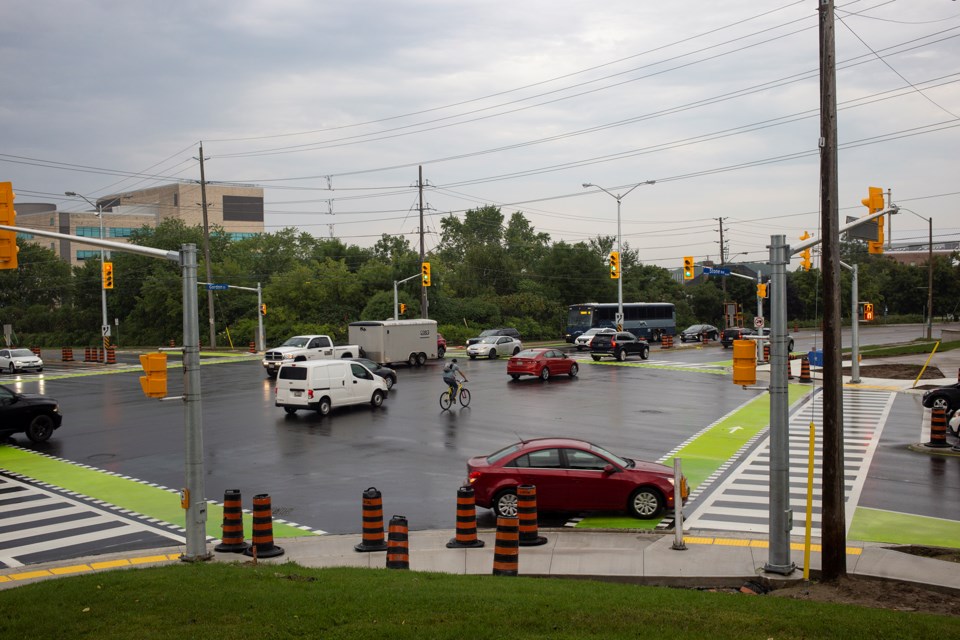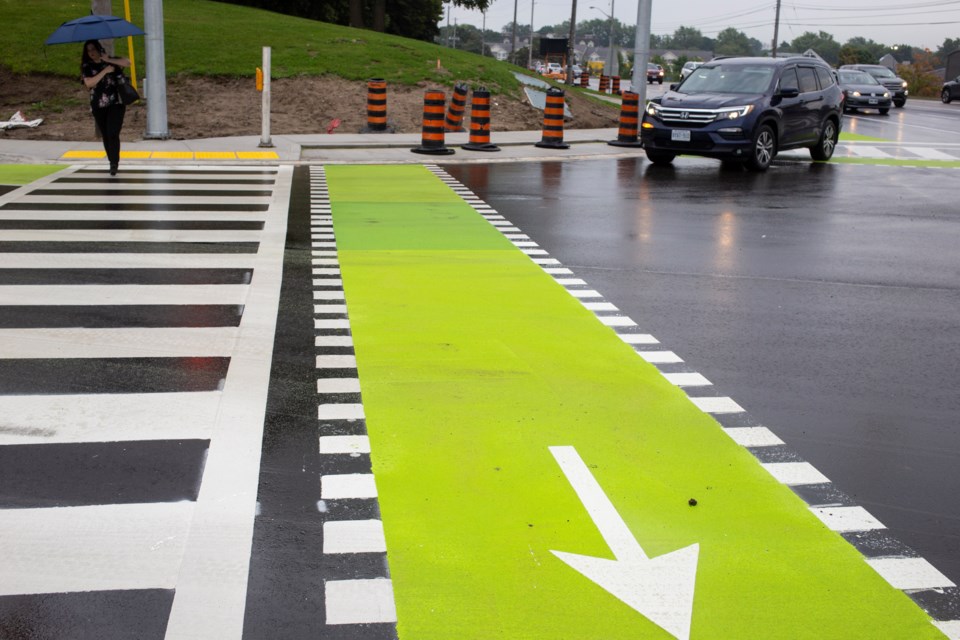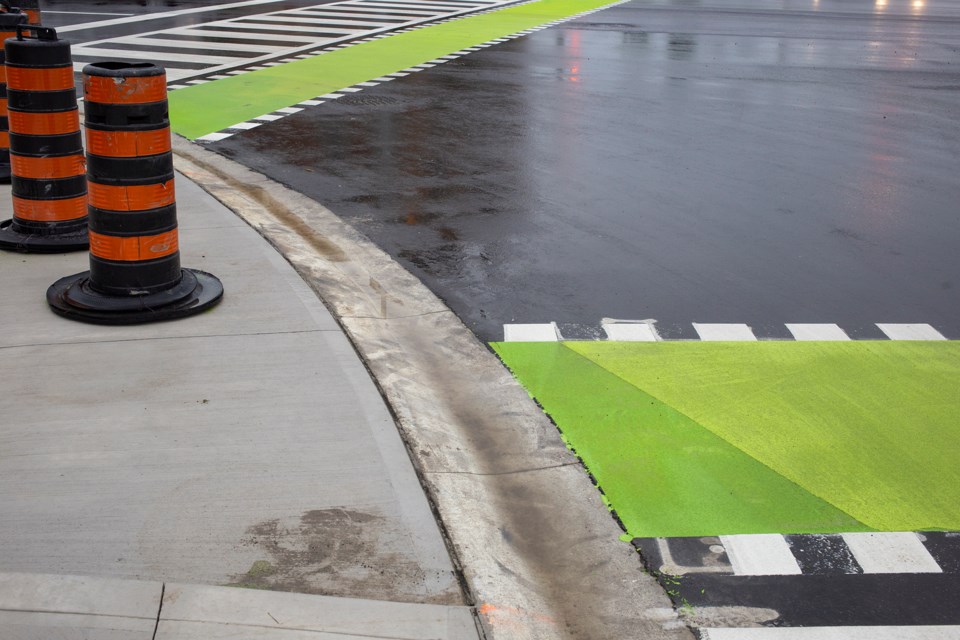Monarch Butterfly
Superstar
Sorry, couldn't resist:
Make no mistake, bells, like horns, have a very valuable use: *Alert!*...but using it for anything less is an annoyance or worse. It puts other cyclists and pedestrians on edge, as it's meant to do exactly that for *emergencies*...or if need be, the smallest of tingles for the purpose of being gracious...and that's not "get out of my way because I'm entitled".
Just in from a medium distance jaunt now, over 50 km, under 100 km, bit of a calamity due to cycling partner's mechanical problems, and it ended up with discovering his frame is fractured. Guess who always brings a road tool kit and had to do the dirty work. Long story short, hopefully he invests in a better one. (Easy for me to say, I ride a modified racing classic) A classic is always worth reinvesting in. Consumer items aren't.
It probably got fractured doing the 'through the woods' trail I love taking as a shortcut (and to avoid traffic) between Limestone Rd and Side Rd 3:
https://www.google.ca/maps/place/Ke...d75ac4d5609c57!8m2!3d43.5079351!4d-79.9401497
Whatever, we were discussing the "ding-a-lings" and the absolutely flagrant disregard for pedestrians going through crosswalks. And some motorists are just as bad. They don't even follow the old HTA regs of split road direction wait for peds to reach sidewalk, let alone the new regs that require stopping until *any* sidewalk or island is reached.
There's a number of us older cyclists becoming very vocal now with other cyclists. They know when they're being called out and why, and it's only the rare and brave that respond...best I leave it at that for now.
Absolutely! That's common courtesy, not incessant declaration of entitlement. Just as a motorist can tap the horn to give a 'heads-up' to someone who doesn't see them coming, it's the opposite of standing on the horn incessantly demanding people get out of your way.I rode about 100k today on Toronto Trails. While heading south beside the Don River a woman jumped aside and yelled at the lead in our group to use his bell. We weren't pressing her. It was just the relative speed we were at when passing surprised her. It is common courtesy to give a little ring when passing pedestrians from behind and a mention of on your left as you overtake other riders.
It minimizes surprises and keeps everyone safer.
https://www.smh.com.au/lifestyle/cyclists-ringing-bells-considerate-or-annoying-20150121-12v2zn.html[...]
So what's the best way to do it? Sophie Bartho of Bicycle NSW says cyclists should "ring your bell well in advance, always pass slowly at a safe distance".
A lot of it has to do with attitude, she adds. "The bell should be a friendly 'tingle', not a jarring 'ring ring ring'. Always use it with respect and courtesy, and the best finale is a 'thank you' and a wave." [...]
https://www.thestar.com/news/gta/tr...09/bike_bells_essential_or_just_annoying.htmlPeople in cars don’t hear them, and those on foot just get confused or annoyed.
They’re useless, sums up Darren Stehr, a volunteer and spokesperson at Advocacy for Respect for Cyclists in Toronto.
“I have a bell on my bike. I wouldn’t use it other than to avoid getting a ticket for not having a bell,” said Stehr, referring to the provincial law requiring them.
That rule, and the jingly din that accompanies it, is a sore spot for some road users. Readers commenting on thestar.com Wednesday debated the issue, some lambasting bike bells as aggravating and overused.
“The supreme arrogance of cyclists can be heard every time they pass you on the bike path ringing those goddamned bells,” said one user.
“I may start doing the same to them when I’m in my car. When I see a cyclist on the road, I will start honking my horn like a maniac.”
[...]
“If a cyclist is on the sidewalk, don’t ring your bell at pedestrians. You’re not supposed to be there in the first place,” he said, describing how he’s been chimed while crossing an intersection, by a cyclist speeding toward him through a red light. “That’s the most aggravating thing.”
Reid points out that cyclists also have the choice of using their voices. He prefers ringing to verbal alerts, but added that cyclists “can do an angry ring or they can do a polite ring. Most of the time a light ring should be fine.”
Conversely, Stehr said verbal alerts are safer, as they can include the direction from which they’re approaching a pedestrian, for example.
And although Stehr questioned whether drivers can even hear bike bells, Reid had a message for those bothered by ringing: “If you’re a driver and you’re finding that cyclists are ringing at you a lot, maybe you should look at your driving.”
https://www.theguardian.com/environment/green-living-blog/2009/oct/22/cyclist-bell-etiquetteAs long as you don't fall in, the canal towpath in London should be a lovely place to cycle. I have a cheerful ding-dong bell that I bought especially to use there, because banners all along the route say: "Ting your bell twice, pass slowly, be nice." And my mum said: "You must get a bell – if you cycle around people without ringing your bell first, it always gives them a fright." Plus the lady who I cycled round at 4mph with a wide berth on my first, bell-free, week, said to her companion in a stage bellow: "OH, I DIDN'T HEAR A BELL, DID YOU, DEAR?"
[...]
Personally, when I'm on foot, I don't like bells. I can never get past the undertone of reprimand. The Highway Code says car horns should only be used "to warn other road users of your presence"; and bells are to "let [road users] know you are there when necessary". Yeah yeah. The fact is that car horns don't say "Ahem...", they say "Oi, dickhead!", and for many pedestrians, bells do too.
So, for anywhere where bells are prescribed as an essential part of the journey, I've had enough. Whenever there's a pedestrian in my way on a road, I'll slow down and/or try to go around them, and call out if necessary (although alerting someone who is on a semi-predictable course can be the worst thing to do). When I have to go on a "shared use" path, the right of way is theirs, so I'll slow down to walking pace and speak as I approach. And no, I won't cycle on the pavement.
So my bell will be silenced. I can't deal with the etiquette. It's worse than a Japanese tea ceremony. I'm going back to take my chances with the buses and the potholes on the Marylebone Road. I'll leave the towpath to cyclists of a stronger disposition, and the pedestrians who – rightly or not – seem destined always to fear them.
Absolutely! That's common courtesy, not incessant declaration of entitlement. Just as a motorist can tap the horn to give a 'heads-up' to someone who doesn't see them coming, it's the opposite of standing on the horn incessantly demanding people get out of your way.
I'm afraid far too many cyclists think they have carte-blanche to do as they wish. It's become so blatant that some motorists roll down their windows to thank me for observing stop signs and red lights, let alone signalling turns and stops.
At this rate, road protocol is getting completely lost. An example in the vehicular world is how roundabouts don't work the way they used to a generation or more back. Very few signal, let alone even know where they're going, who is beside and behind them, and how that lack of awareness is everyone's downfall.
I used to cycle through roundabouts (in Europe and the ones here and in the US) when I was younger, when most everyone knew 'how to dance'. That's almost gone now, and I walk around or across roundabouts. They're almost completely unpredictable. And everyone is the lesser for it.
Thank you for a gentlemanly post, btw! Courtesy is the stuff of choreography, and we can all enjoy it.
Addendum: Just reading up to see what's published on the incessant "ting-a-lings", and there's reams!
Some examples:
https://www.smh.com.au/lifestyle/cyclists-ringing-bells-considerate-or-annoying-20150121-12v2zn.html
https://www.thestar.com/news/gta/tr...09/bike_bells_essential_or_just_annoying.html
https://www.theguardian.com/environment/green-living-blog/2009/oct/22/cyclist-bell-etiquette
All excellent discussion on the *courtesy* protocol. But my patience is limited. And if another cyclist is wearing headphones, or a skateboarder, skater or pedestrian, I resort to obscenities sometimes when they think *they* are wholly entitled to the road/lane/path when you've used your bell at its max, and they still don't respond.
I'm reminded of my long passed mother: "Good manners will take you a long way in life Stephen". Very proper European, but people have a habit of taking advantage sometimes. And as the brash North American in the family, I learned to cycle quietly, and carry a large stick. (Nod to U.S. President Theodore Roosevelt's foreign policy: "speak softly and carry a big stick.")
Manners go a long with with courteous people. For the rest, it's an invitation to do as they wish...
Most bike bells are capable of being used minimally, just a little ting usually gets attention from most pedestrians, and then follow that with "passing on your left" (or if pedestrian is on the other side of the path, "on your right") spoken clearly but softly.I'm quite keen, as a pedestrian on multiuse trail to hear' on your left' in addition to the bell.
Because there can be traffic coming the other way, in addition to whatever space I or a friend may be occupying, I don't take for granted which side I might be passed on.
Etiquette rules for cars, never mind everyone else, says you always pass to the left, but in the real world, its not always so; as such I like the predictability of where to expect a rush of wind, and also which way to move to give someone a bit of extra space.
A lot of them are self entitled assholes. I have had a few run-ins with a quite a few lately, and I note a number of other older, but well muscled and disciplined cyclists yelling at the jerks. Best I stop there, save to say that there's a responsibility to call out the jerks, just as there is for calling out idiot/asshole drivers and pedestrians, just to let them know what they are. Unfortunately, road protocol and manners are getting rare...it's basic common sense and consideration, let alone law, to share intentions to let others adjust accordingly. I've had drivers cheer me when I've yelled at cyclists just flying through red lights and crosswalks, barely missing pedestrians.Went for my weekly run again today - came across an annoying cyclist on MGT who dinged his bell no less than ten times in a row on a narrow spot; glared at a few other obnoxious bell ringers. Steve, you're a bad influence on me!
https://www.ft.com/content/986d878a-a7c4-11e8-8ecf-a7ae1beff35bUber gears up for shift to bikes on short trips Khosrowshahi concedes possible short-term hit to revenues 'During rush hour, it is very inefficient for a one-tonne hulk of metal to take one person 10 blocks,' said Dara Khosrowshahi Share on Twitter (opens new window) Share on Facebook (opens new window) Share on LinkedIn (opens new window) Save to myFT Shannon Bond in San Francisco 9 hours ago Print this page 18 Uber is planning a shift in emphasis from cars to electric bicycles and scooters for shorter journeys as part of its long-term strategy, according to the ride-hailing app’s chief executive. Dara Khosrowshahi said more individual modes of transport were better suited to inner-city travel, despite snatching revenues away from Uber’s drivers. He admitted that in the short term the move would mean a further financial hit for a company that had losses of $4.5bn last year. Ahead of Uber’s highly anticipated flotation, Mr Khosrowshahi said investors had to be aware that short-term losses were necessary to achieve longer-term goals — and part of that was a focus away from cars in inner cities. “During rush hour, it is very inefficient for a one-tonne hulk of metal to take one person 10 blocks,” he told the Financial Times in an interview. “We’re able to shape behaviour in a way that’s a win for the user. It’s a win for the city. Short-term financially, maybe it’s not a win for us, but strategically long term we think that is exactly where we want to head.”
[...]
The number one reason buyers give for getting into an SUV or light truck is always that they feel safer. Higher up. Bigger. All those things are actually true.
But spare some sympathy for the rest of us, who are getting injured and killed at disproportionate rates. Add in a study showing that driving the super-sized vehicles is “masculanizing” how females are driving, and it starts to make sense why after years of declining numbers, fatal road traffic collisions are heading back up. The vehicles we drive have never been safer; manufacturers have seen to that. Now, it’s the drivers alone extending the carnage on our roads.
Professor Michelle J. White, a researcher at the University of California, San Diego, first noted the problem in a paper way back in 2004 and appropriately called it an “arms race”. She noticed the steady increase in larger and larger vehicles on North American roads, and the impact that had on “occupants of smaller vehicles and to pedestrians, bicyclists, and motorcyclists.” Anyone who knows even a bit of physics might shrug; big beats little in the event of a collision, every time. [...]
New protected intersection for cyclists opens at Stone and Gordon
The protected intersection is different than the green bike box used further north on Gordon Street at Waterloo Avenue
by: Kenneth Armstrong, Guelph Today



https://www.guelphtoday.com/local-n...or-cyclists-opens-at-stone-and-gordon-10273043 / 3 A new protected intersection for cyclists opened Monday at Gordon Street and Stone Road. The cement corners will be painted green in about a month, after the cement cures. Kenneth Armstrong/GuelphToday
The city’s first protected intersection for cyclists opened at Stone Road and Gordon Street on Monday morning, allowing cyclists a safer option when making a left turn at that intersection.
Stone Road and Gordon Street is one of the city’s busiest intersections, said Jennifer Juste, transportation coordinator for the city of Guelph.
“With the number of cyclists navigating this intersection, it made sense to give them a bit of added protection to feel safe and to ensure they are complying with the rules of the road — not biking on the sidewalk and using the crosswalk,” said Juste.
Cyclists approaching the intersection may still navigate through the intersection the same way as before, said Juste, or they can choose to use the protected intersection when making a left turn — which will save them from crossing almost three lanes of traffic to get into the left turning lane.
“This helps cyclists not having to change lanes in live traffic to make a left turn, and then wait in the middle of an intersection. It gives them the opportunity to go with the green light, wait on the corner and then take the next green light across and continue on their way,” said Juste. “Having to cross two and a half lanes or traffic to get to the left turn lane, that can be intimidating for a lot of cyclists.”
The protected intersection’s green cross ride is painted alongside the pedestrian crosswalk. It has a white arrow painted on it to show the cyclists’ path is intended as a one-way, maintaining a counter-clockwise direction in the intersection.
“The green cross ride is a designed for cyclists that allow them to stay on their bicycle without having to dismount and walk and it’s beside the crosswalk,” said Juste.
If a cyclist uses a crosswalk, they are supposed to dismount their bicycle.
The corner areas where turning cyclists can queue still need to be painted. Juste said the concrete in those areas needs to cure for up to a month before being painted.
For drivers, said Juste, there is really no change.
“There will be a new sign introduced asking drivers to yield when turning right — to watch for cyclists, because it is unique to have them coming from your blind spot,” said Juste.
She said there is a benefit to drivers because the cyclist path and pedestrian walkway are pushed back, so drivers have more time to stop if making a right turn and there is someone using those paths.
A similar protected intersection was rolled out this summer in neighbouring Waterloo, said Juste.
“The city of Ottawa has quite a few of them that they have introduced in the last year or two, as well.” She said.
Because construction work was already being done on the Gordon and Stone intersection, Juste said the cost was negligible.
“It was just paint work and a bit of additional concrete work, so it wasn’t a significant cost to do this,” said Juste.
The protected intersection is different than the green bike box used further north on Gordon Street at Waterloo Avenue.
The city chose not to do the green bike box design on Gordon and Stone because of how many lanes of traffic cyclists would still have to cross and how far that left turn path is.
A survey of cyclists conducted by the city after the Gordon and Waterloo green bike box rollout showed they liked the design, but still wanted additional protection.
“We felt this (protected intersection) design was more suitable for an intersection of this size,” said Juste.




